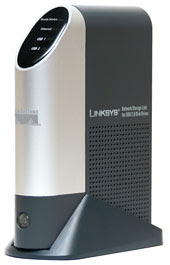 a network using the SMB protocol (also known as Windows file sharing or CIFS). It was superseded mainly by the NAS200 (enclosure type storage link) and in another sense by the WRT600N which combines a wifi router with a storage link.
a network using the SMB protocol (also known as Windows file sharing or CIFS). It was superseded mainly by the NAS200 (enclosure type storage link) and in another sense by the WRT600N which combines a wifi router with a storage link.The device runs a modified version of Linux and by default, formats hard disks with the ext3 filesystem, but a firmware upgrade from Linksys adds the ability to use NTFS and FAT32 formatted drives with the device for better Windows compatibility. The device has a web interface from which the various advanced features can be configured, including user and group permissions and networking options. It runs on almost all systems. It does not make much noise and can also be used as a Web Server..
- USB 1.1 & USB 2.0 compliant
- Port 1: USB HDDs (DOES NOT RECOGNIZE FLASH DRIVES)
- Port 2: USB Flash Drives (detected only by port 2)
T
 he Default IP Address of NSLU2 is 192.168.1.77. To reset the device press the reset button down for 3 seconds it will beep once to indicate the reset has occurred. The default password is "admin".
he Default IP Address of NSLU2 is 192.168.1.77. To reset the device press the reset button down for 3 seconds it will beep once to indicate the reset has occurred. The default password is "admin".Important: Resetting the Network Storage Link will erase all of your settings and replace them with the factory defaults. Do not reset the Network Storage Link if you want to retain the settings. Data on the drives is NOT lost even if the unit is reset to Factory Defaults.
The device includes 32 MB of SDRAM, and 8 MB of Flash memory. It also has a 100 megabit Ethernet network connection.
The Network Storage Link features built-in disk utilities that are accessible through your web browser. You can format a drive for initial use, and scan the disk for errors. If you've installed a second Network Storage Link, you can back up data from one Network Storage Link to the other. You can also automatically back up data to or from a shared folder on a Windows system on your network.
For even more flexibility and utility, the Network Storage Link can be set up to be accessible directly from the Internet, which allows access to stored files via a web browser. Files can be available publicly in your network, or you can create password-protected accounts for your authorized users. You can format new disk drives, and scan drives for errors. The built-in backup program lets you schedule full, incremental, or synchronization backups of your network drives to the Network Storage Link, or vice versa. It will even send you an email message when a hard drive gets nearly full, completely full, or has an error.
No comments:
Post a Comment